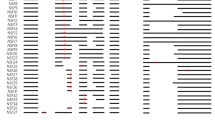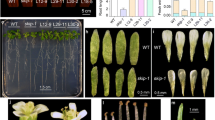Abstract
Key message
The AtSF1-FLM module spatially controls temperature-dependent flowering by negatively regulating the expression of FT and LFY in the leaf and shoot apex, respectively.
Abstract
Alternative splicing mediated by various splicing factors is important for the regulation of plant growth and development. Our recent reports have shown that a temperature-dependent interaction between Arabidopsis thaliana splicing factor 1 (AtSF1) and FLOWERING LOCUS M (FLM) pre-mRNA introns controls the differential production of FLM-β transcripts at different temperatures, eventually resulting in temperature-responsive flowering. However, the molecular and genetic interactions between the AtSF1-FLM module and floral activator genes remain unknown. Here, we aimed to identify the interactions among AtSF1, FLM, FLOWERING LOCUS T (FT), and LEAFY (LFY) by performing molecular and genetic analyses. FT and TWIN SISTER OF FT (TSF) expression in atsf1-2 mutants significantly increased in the morning and middle of the night at 16 and 23 °C, respectively, under long-day conditions. In addition, ft mutation suppressed the early flowering of atsf1-2 and atsf1-2 flm-3 mutants and masked the temperature response of atsf1-2 flm-3 mutants, suggesting that FT is a downstream target gene of the AtSF1-FLM module. LFY expression significantly increased in the diurnal samples of atsf1-2 mutants and in the shoot apex regions of atsf1-2 ft-10 mutants at different temperatures. The chromatin immunoprecipitation (ChIP) assay revealed that FLM directly binds to the genomic regions of LFY but not of APETALA1 (AP1). Moreover, lfy mutation suppressed the early flowering of flm-3 mutants, suggesting that LFY is another target of the AtSF1-FLM module. Our results reveal that the AtSF1-FLM module spatially modulates temperature-dependent flowering by regulating FT and LFY expressions.





Similar content being viewed by others
Change history
03 November 2022
A Correction to this paper has been published: https://doi.org/10.1007/s00299-022-02946-y
References
Arning S, Gruter P, Bilbe G, Kramer A (1996) Mammalian splicing factor SF1 is encoded by variant cDNAs and binds to RNA. RNA 2:794–810
Capovilla G, Pajoro A, Immink RG, Schmid M (2015) Role of alternative pre-mRNA splicing in temperature signaling. Curr Opin Plant Biol 27:97–103
Capovilla G, Symeonidi E, Wu R, Schmid M (2017) Contribution of major FLM isoforms to temperaturedependent flowering in Arabidopsis thaliana. J Exp Bot
Castillejo C, Pelaz S (2008) The balance between CONSTANS and TEMPRANILLO activities determines FT expression to trigger flowering. Curr Biol 18:1338–1343
Chamala S, Feng G, Chavarro C, Barbazuk WB (2015) Genome-wide identification of evolutionarily conserved alternative splicing events in flowering plants. Front Bioeng Biotechnol 3:33
Chang P, Hsieh HY, Tu SL (2021) The U1 snRNP component RBP45d regulates temperature-responsive flowering in Arabidopsis. The Plant cell
Chaudhary S, Khokhar W, Jabre I, Reddy ASN, Byrne LJ, Wilson CM, Syed NH (2019) Alternative splicing and protein diversity: plants versus animals. Front Plant Sci 10:708
Corbesier L, Vincent C, Jang S, Fornara F, Fan Q, Searle I, Giakountis A, Farrona S, Gissot L, Turnbull C, Coupland G (2007) FT protein movement contributes to long-distance signaling in floral induction of Arabidopsis. Science 316:1030–1033
Deng X, Cao X (2017) Roles of pre-mRNA splicing and polyadenylation in plant development. Curr Opin Plant Biol 35:45–53
Hempel FD, Weigel D, Mandel MA, Ditta G, Zambryski PC, Feldman LJ, Yanofsky MF (1997) Floral determination and expression of floral regulatory genes in Arabidopsis. Development 124:3845–3853
Jang YH, Park HY, Lee KC, Thu MP, Kim SK, Suh MC, Kang H, Kim JK (2014) A homolog of splicing factor SF1 is essential for development and is involved in the alternative splicing of pre-mRNA in Arabidopsis thaliana. Plant J 78:591–603
Kalyna M, Simpson CG, Syed NH, Lewandowska D, Marquez Y, Kusenda B, Marshall J, Fuller J, Cardle L, McNicol J, Dinh HQ, Barta A, Brown JW (2012) Alternative splicing and nonsense-mediated decay modulate expression of important regulatory genes in Arabidopsis. Nucleic Acids Res 40:2454–2469
Kaufmann K, Wellmer F, Muino JM, Ferrier T, Wuest SE, Kumar V, Serrano-Mislata A, Madueno F, Krajewski P, Meyerowitz EM, Angenent GC, Riechmann JL (2010) Orchestration of floral initiation by APETALA1. Science 328:85–89
Kinmonth-Schultz HA, Tong X, Lee J, Song YH, Ito S, Kim SH, Imaizumi T (2016) Cool night-time temperatures induce the expression of CONSTANS and FLOWERING LOCUS T to regulate flowering in Arabidopsis. New Phytol 211:208–224
Klepikova AV, Logacheva MD, Dmitriev SE, Penin AA (2015) RNA-seq analysis of an apical meristem time series reveals a critical point in Arabidopsis thaliana flower initiation. BMC Genomics 16:466
Kurihara Y, Matsui A, Hanada K, Kawashima M, Ishida J, Morosawa T, Tanaka M, Kaminuma E, Mochizuki Y, Matsushima A, Toyoda T, Shinozaki K, Seki M (2009) Genome-wide suppression of aberrant mRNA-like noncoding RNAs by NMD in Arabidopsis. Proc Natl Acad Sci USA 106:2453–2458
Lee JH, Yoo SJ, Park SH, Hwang I, Lee JS, Ahn JH (2007) Role of SVP in the control of flowering time by ambient temperature in Arabidopsis. Genes Dev 21:397–402
Lee JH, Ryu HS, Chung KS, Pose D, Kim S, Schmid M, Ahn JH (2013) Regulation of temperature-responsive flowering by MADS-box transcription factor repressors. Science 342:628–632
Lee JH, Chung KS, Kim S, Ahn JH (2014) Post-translational regulation of SHORT VEGETATIVE PHASE as a major mechanism for thermoregulation of flowering. Plant Signal Behav 9:e28193
Lee KC, Jang YH, Kim SK, Park HY, Thu MP, Lee JH, Kim JK (2017) RRM domain of Arabidopsis splicing factor SF1 is important for pre-mRNA splicing of a specific set of genes. Plant Cell Rep 36:1083–1095
Lee KC, Chung KS, Lee HT, Park JH, Lee JH, Kim JK (2020) Role of Arabidopsis splicing factor SF1 in temperature-responsive alternative splicing of FLM pre-mRNA. Front Plant Sci 11:596354
Liu Z, Luyten I, Bottomley MJ, Messias AC, Houngninou-Molango S, Sprangers R, Zanier K, Kramer A, Sattler M (2001) Structural basis for recognition of the intron branch site RNA by splicing factor 1. Science 294:1098–1102
Livak KJ, Schmittgen TD (2001) Analysis of relative gene expression data using real-time quantitative PCR and the 2(-Delta Delta C(T)) Method. Methods 25:402–408
Lutz U, Pose D, Pfeifer M, Gundlach H, Hagmann J, Wang C, Weigel D, Mayer KF, Schmid M, Schwechheimer C (2015) Modulation of ambient temperature-dependent flowering in arabidopsis thaliana by natural variation of FLOWERING LOCUS M. PLoS Genet 11:e1005588
Lutz U, Nussbaumer T, Spannagl M, Diener J, Mayer KF, Schwechheimer C (2017) Natural haplotypes of FLM non-coding sequences fine-tune flowering time in ambient spring temperatures in Arabidopsis. eLife 6
Marquez Y, Hopfler M, Ayatollahi Z, Barta A, Kalyna M (2015) Unmasking alternative splicing inside protein-coding exons defines exitrons and their role in proteome plasticity. Genome Res 25:995–1007
Michaels SD, Amasino RM (1999) FLOWERING LOCUS C encodes a novel MADS domain protein that acts as a repressor of flowering. Plant Cell 11:949–956
Moon J, Lee H, Kim M, Lee I (2005) Analysis of flowering pathway integrators in Arabidopsis. Plant Cell Physiol
Park HY, Lee HT, Lee JH, Kim JK (2019) Arabidopsis U2AF65 regulates flowering time and the growth of pollen tubes. Front Plant Sci 10:569
Pose D, Verhage L, Ott F, Yant L, Mathieu J, Angenent GC, Immink RG, Schmid M (2013) Temperature-dependent regulation of flowering by antagonistic FLM variants. Nature 503:414–417
Postma M, Goedhart J (2019) PlotsOfData-A web app for visualizing data together with their summaries. PLoS Biol 17:e3000202
Selenko P, Gregorovic G, Sprangers R, Stier G, Rhani Z, Kramer A, Sattler M (2003) Structural basis for the molecular recognition between human splicing factors U2AF65 and SF1/mBBP. Mol Cell 11:965–976
Song YH, Kubota A, Kwon MS, Covington MF, Lee N, Taagen ER, Laboy Cintron D, Hwang DY, Akiyama R, Hodge SK, Huang H, Nguyen NH, Nusinow DA, Millar AJ, Shimizu KK, Imaizumi T (2018) Molecular basis of flowering under natural long-day conditions in Arabidopsis. Nat Plants 4:824–835
Staiger D, Brown JW (2013) Alternative splicing at the intersection of biological timing, development, and stress responses. Plant Cell 25:3640–3656
Steffen A, Elgner M, Staiger D (2019) Regulation of flowering time by the RNA-binding proteins AtGRP7 and AtGRP8. Plant Cell Physiol 60:2040–2050
Sureshkumar S, Dent C, Seleznev A, Tasset C, Balasubramanian S (2016) Nonsense-mediated mRNA decay modulates FLM-dependent thermosensory flowering response in Arabidopsis. Nat Plants 2:16055
Syed NH, Kalyna M, Marquez Y, Barta A, Brown JW (2012) Alternative splicing in plants–coming of age. Trends Plant Sci 17:616–623
Wahl MC, Will CL, Luhrmann R (2009) The spliceosome: design principles of a dynamic RNP machine. Cell 136:701–718
Wang W, Maucuer A, Gupta A, Manceau V, Thickman KR, Bauer WJ, Kennedy SD, Wedekind JE, Green MR, Kielkopf CL (2013) Structure of phosphorylated SF1 bound to U2AF(6)(5) in an essential splicing factor complex. Structure 21:197–208
Weigel D, Glazebrook J (2002) Arabidopsis: a laboratory manual. Cold Spring Harbor Laboratory Press, Cold Spring Harbor
Will CL, Luhrmann R (2011) Spliceosome structure and function. Cold Spring Harb Perspect Biol 3
Yoo SK, Chung KS, Kim J, Lee JH, Hong SM, Yoo SJ, Yoo SY, Lee JS, Ahn JH (2005) CONSTANS activates SUPPRESSOR OF OVEREXPRESSION OF CONSTANS 1 through FLOWERING LOCUS T to promote flowering in Arabidopsis. Plant Physiol 139:770–778
Zhang Y, Madl T, Bagdiul I, Kern T, Kang HS, Zou P, Mausbacher N, Sieber SA, Kramer A, Sattler M (2013) Structure, phosphorylation and U2AF65 binding of the N-terminal domain of splicing factor 1 during 3’-splice site recognition. Nucleic Acids Res 41:1343–1354
Zhang R, Calixto CPG, Marquez Y, Venhuizen P, Tzioutziou NA, Guo W, Spensley M, Entizne JC, Lewandowska D, Ten Have S, Frei Dit Frey N, Hirt H, James AB, Nimmo HG, Barta A, Kalyna M, Brown JWS (2017) A high quality Arabidopsis transcriptome for accurate transcript-level analysis of alternative splicing. Nucleic Acids Res 45:5061–5073
Zhang G, Sun M, Wang J, Lei M, Li C, Zhao D, Huang J, Li W, Li S, Li J, Yang J, Luo Y, Hu S, Zhang B (2019) PacBio full-length cDNA sequencing integrated with RNA-seq reads drastically improves the discovery of splicing transcripts in rice. Plant J 97:296–305
Acknowledgements
We are grateful to Ji Hoon Ahn (Korea University) and Ilha Lee (Seoul National University) for providing the ft-10 and lfy-12 mutant seeds. We also thank Kyung Sook Chung and A Mi Yoon for technical assistance.
Funding
Financial support for this work was provided by the Basic Science Research Program through a National Research Foundation of Korea (NRF) grant funded by the Ministry of Education (2019R1F1A1060009 to J.-K. Kim and 2019R1F1A1043700 to J.H. Lee) and a Korea University Grant (to J.-K. Kim). This work was also supported in part by a grant (PJ01532503 to J.H. Lee) from the Rural Development Administration (RDA), Republic of Korea.
Author information
Authors and Affiliations
Contributions
J-KK and JHL conceived and designed the research. KCL, HTL, HHJ, J-HP, and Y-CK conducted experiment. KCL, HTL, JHL, and J-KK analysed data. JHL and J-KK wrote the manuscript. All authors read and approved the manuscript.
Corresponding authors
Ethics declarations
Conflict of interest
The authors have no relevant financial or non-financial interests to disclose.
Additional information
Communicated by Youn-Il Park.
Publisher's Note
Springer Nature remains neutral with regard to jurisdictional claims in published maps and institutional affiliations.
Supplementary Information
Below is the link to the electronic supplementary material.
Rights and permissions
Springer Nature or its licensor (e.g. a society or other partner) holds exclusive rights to this article under a publishing agreement with the author(s) or other rightsholder(s); author self-archiving of the accepted manuscript version of this article is solely governed by the terms of such publishing agreement and applicable law.
About this article
Cite this article
Lee, K.C., Lee, H.T., Jeong, H.H. et al. The splicing factor 1–FLOWERING LOCUS M module spatially regulates temperature-dependent flowering by modulating FLOWERING LOCUS T and LEAFY expression. Plant Cell Rep 41, 1603–1612 (2022). https://doi.org/10.1007/s00299-022-02881-y
Received:
Accepted:
Published:
Issue Date:
DOI: https://doi.org/10.1007/s00299-022-02881-y




